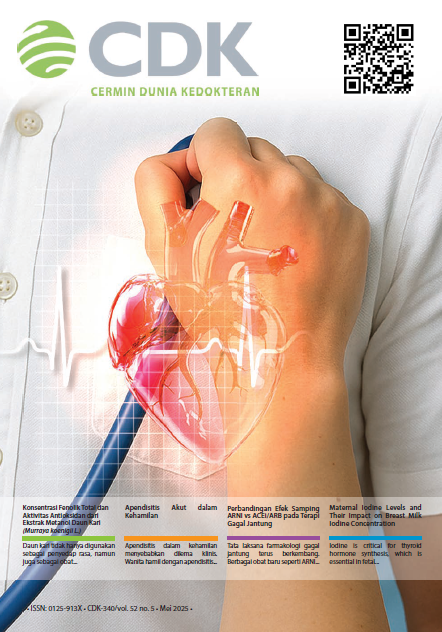The Relationship of Fast Food Consumption Behavior towards Severity of Acne Vulgaris in Male Students
Research
DOI:
https://doi.org/10.55175/cdk.v52i5.1291Keywords:
Acne vulgaris, fast food, male studentAbstract
Introduction: Acne vulgaris has the highest prevalent skin disease in the world, with food is one of the most common triggers in adolescents. Availability of fast food has influenced young adults eating pattern. This study aims to determine the relationship between frequency of fast food consumption and severity of acne vulgaris in male students. Methods: This cross-sectional study was conducted on 129 male students. Frequency of fast food consumption and severity of acne vulgaris was measured using a modified FFQ questionnaire and GAGS score. Data were processed with STATA and analyzed using Chi-square. Results: The result showed that 65.89% male students often consumed fast food and the majority of respondents experienced mild acne vulgaris (55.81%). There was a significant relationship between frequency of fast food consumption and severity of acne vulgaris (p=0.020). Conclusion: The results of this study suggest a significant relationship between frequency of fast food consumption and severity of acne vulgaris among male students.
Downloads
References
Zaenglein AL, Graber EM, Thiboutot DM. Ch. 80. Acne vulgaris and acneiform eruptions. In: Goldsmith LA, Katz Gilchrest BA, Paller AS, Leffell DJ, Wolff K, editors. Fitzpatrick's dermatology in general medicine, 8e. McGraw Hill; 2012.
Sutaria AH, Masood S, Schlessinger J. Acne vulgaris. StatPearls [Internet]. 2022 Jan. Available from: https://www.ncbi.nlm.nih.gov/books/NBK459173/.
Vos T, Flaxman AD, Naghavi M, Lozano R, Michaud C, Ezzati M, et al. Years lived with disability (YLDs) for 1160 sequelae of 289 diseases and injuries 1990-2010: A systematic analysis for the Global Burden of Disease Study 2010. Lancet. 2012;380(9859):2163-96. DOI:10.1016/S0140-6736(12)61729-2).
Afriyanti RN. Akne vulgaris pada remaja. J Majority [Internet]. 2015 [cited 2022 Aug 6];4(5). Available from: https://juke.kedokteran.unila.ac.id/index.php/majority/article/view/616.
Ayudianti P, Indramaya DM. Retrospective study: Factors aggravating acne vulgaris. J Berkala Ilmu Kes Kulit Kelamin. 2014;26(1):41–7.
Widyastuti DA. Pengaruh kebiasaan konsumsi junk food terhadap kejadian obesitas remaja [Internet]. 2018. Available from: osf.io/7d8ey.
Kementerian Kesehatan. Hindari makanan tinggi kolesterol - Penyakit tidak menular Indonesia [Internet]. Available from: https://p2ptm.kemkes.go.id/tag/hindari-makanan-tinggi-kolesterol .
HMIG UNDIP. Giziklopedia; 2022
Yanti Rahman R. Hubungan makanan cepat saji terhadap timbulnya acne vulgaris di SMAN 6 Makassar. Universitas Muhammadiyah Makassar [Internet]. 2018. Available from: https://digilibadmin.unismuh.ac.id/upload/5520-Full_Text.pdf
Fitri Syam N. Hubungan makanan cepat saji terhadap timbulnya acne vulgaris di SMA Negeri 19 Makassar. Universitas Muhammadiyah Makassar [Internet]. 2018. Available from: https://digilibadmin.unismuh.ac.id/upload/7927-Full_Text.pdf.
Adityan B, Kumari R, Thappa DM. Scoring systems in acne vulgaris. Indian J Dermatol Venereol Leprol. 2009;75(3):323–6. DOI: 10.4103/0378-6323.51258.
Fajri L, Minerva P. The relationship of fast food towards the event of acne vulgaris in students. Internat J Natural Sci Engineering. 2022;6(2):55–63. DOI: 10.23887/ijnse.v6i2.51640.
Bajelan A, Ghaebi M, Javadi M, Barikani A, Beheshti A, Bargahi M, et al. The association between the incidence of acne vulgaris and lifestyle factors including dietary habits, physical activity, and bathing frequency. J Skin Stem Cell. 2021;7(3):e114161. DOI: 10.5812/jssc.114161.
Syahputra A, Anggreni S, Handayani DY, Rahmadhani M. Pengaruh makanan akibat timbulnya acne vulgaris (jerawat) pada mahasiswa mahasiswi FK UISU tahun 2020. J Kedokt STM [Internet]. 2021;4(2):75–82. DOI: 10.30743/stm.v4i2.62.
Afnanita S, Nola S, Mardalena E. Faktor-faktor yang mempengaruhi timbulnya acne vulgaris pada remaja remaja santri pesantren Babun Najah. JKT. 2023;27;4(3):3144-51. DOI: 10.31004/jkt.v4i3.17274.
Melnik BC. Linking diet to acne metabolomics, inflammation, and comedogenesis: An update. Clinical, Cosmet Investig Dermatol. 2015;8:371–88. DOI: 10.2147/CCID.S69135.
Sinaga L. Pengaruh pola konsumsi makanan cepat saji terhadap kadar kolesterol siswa kelas XI SMA Negeri 8 dan SMA Pangudi Luhur Yogyakarta. Sanata Dharma University; 2016.
Yang J, Yang H, Xu A, He L. A review of advancement on influencing factors of acne: An emphasis on environment characteristics. Front Public Health 2020;8:450. DOI: 10.3389/fpubh.2020.00450.
Eka Parda Bancin B. Hubungan konsumsi makanan cepat saji terhadap kejadian akne vulgaris pada mahasiswa FK USU Stambuk 2007 [Internet].
Available from: https://123dok.com/document/nzwv21lq-hubungan-konsumsi-makanan-terhadap-kejadian-vulgaris-mahasiswastambuk.html.
Borzyszkowska D, Niedzielska M, Kozłowski M, Brodowska A, Przepiera A, Malczyk-Matysiak K, et al. Evaluation of hormonal factors in acne vulgaris and the course of acne vulgaris treatment with contraceptive-based therapies in young adult women. Cells 2022;11(24):4078. DOI: 10.3390/cells11244078.
Bagatin E, Freitas THP, Rivitti-Machado MC, Machado MCR, Ribeiro BM, Nunes S, et al. Adult female acne: A guide to clinical practice. Anais brasileiros de dermatologia. 2019;94(1):62–75. DOI: 10.1590/abd1806-4841.20198203.
Downloads
Published
How to Cite
Issue
Section
License
Copyright (c) 2025 Mariani Santosa, Cindy Anastasia, Robi Irawan, Lonah, Yuliana, Erwin Yantho

This work is licensed under a Creative Commons Attribution-NonCommercial 4.0 International License.





















